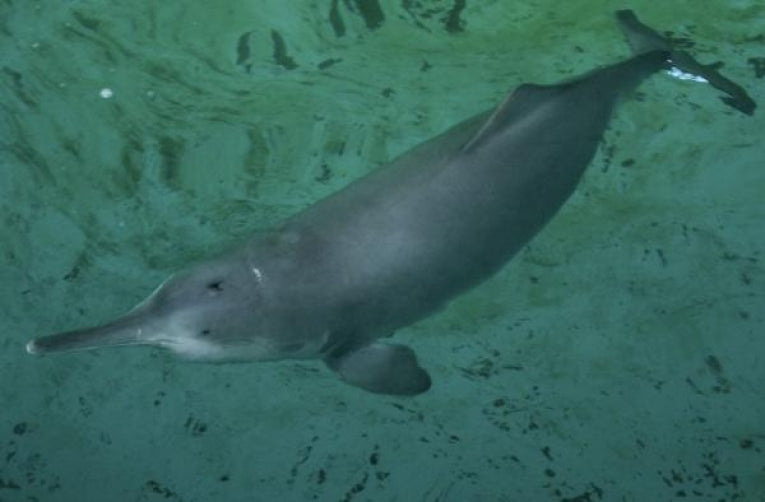Originating beneath the icy glaciers of Geladaindong Peak, the Yangtze River plunges downwards, cutting through elegant gorges, winding across lush plains, before finally entering the East China Sea. Stretching over 6,418 kilometres, it has provided the Chinese heartland with economic lifeblood for decades. Asia's longest river begins near Tibet's border - an unspoiled wilderness, before flowing through China's incredible, yet heavily polluted supercities, including Nanjing and Shanghai.
The pure malachite waters quickly turn brown, contaminated with oil, plastic and sewage. Before the Chinese drove towards industrialisation in the 1950s, the Yangtze was a thriving ecosystem, host to an incredible array of wildlife, including the Chinese alligator, the Yangtze sturgeon and the Yangtze soft-shell turtle. Chief and most loved amongst the animals were the river dolphins, known as Baiji and nicknamed 'Goddess of the Yangtze'. Chinese legend describes the animal as the reincarnation of a young princess who was drowned by her family for refusing to marry a man she did not love. The spectacular appearance of a white Baiji breaking through the murky green water used to be a common site in the river, but sadly, it will never be seen again.
The announcement of the Baiji's extinction was made in December 2006. Long beforehand, scientists and conservationists were filled with trepidation as the dolphin's numbers nosedived. Before 1950, there were an estimated 6,000 animals spread over 1,700 kilometres of the middle and lower Yangtze. This plummeted to 400 by the mid-1980s. By 1997, only 13 remained. What caused such a rapid, shocking decline? Industrialisation was mentioned earlier and of course, this is the chief reason. Mao Zedong implemented a plan known as 'The Great Leap Forward', whereby the country would attempt to replace its predominantly agricultural output with industry.
The Baiji's mythical and sacred status proved unimportant with China's new Communist leadership and it was hunted intensively for meat, oil and leather. This period played a key role in the massive population drop after 1950. The initial damage was done, and gradual human development along the river increased the pressure even further. Sit by the Yangtze and the huge problems manifest themselves immediately. Old men cast nets out into the raging torrent, while a nearby dredger carries out work on the riverbed. All the while, a cacophony of chugging boat engines fills the air - the contrast between upriver and downriver feels unbelievable. The fresh Tibetan breeze at the very beginning of the Yangtze gives way to hanging smog and the stench of petrol mixed with sewage, as it winds its way to a climax. Illegal fishing practices continue here, such as rolling-hook long-lining and electrofishing - long banned and extremely hazardous to wildlife. Statistics from China show that the number of berths on inland rivers has increased hugely over the past three decades, as has shipping traffic.
This heavy traffic proved immensely threatening to the dwindling population of river dolphins. Like their cousins in the Amazon River basin, Baijis evolved with a poor sense of vision. Sight is useless in a murky river like the Yangtze and due to noise pollution, the almost blind dolphins collided frequently with propellers. There were other hazards - the unfortunate animals used echolocation to hunt in the cloudy water, yet struggled to detect fishing nets, often becoming entangled before slowly drowning. The construction of the monumental and controversial Three Gorges Dam ensured the special Yangtze ecosystem would end up lost forever. Shipping increased, while fish stocks slumped even further, resulting in an environmental catastrophe.
A community of scientists banded together in late 2006, in one final attempt to save the Baiji from extinction. The Swiss baiji.org foundation worked together with the Institute of Hydrobiology in Wuhan for six weeks. Experts from the National Oceanic and Atmospheric Administration (NOAA), the Swiss Federal Institute of Aquatic Science, the Hubbs-Seaworld Institute from San Diego and the Fisheries Research Agency in Japan attended as well.
After scanning 3,500 kilometres of river in two research vessels, not a single Baiji was found. On December 13th, 2006, the Baiji was declared 'functionally extinct'. This basically means that even though the research expedition could have missed some isolated individuals, the population would still prove unsustainable. The last confirmed sighting of a live Baiji was in 2004. There was a slight glimmer of hope in August 2007, when a Chinese man came forward with video footage of a large white dolphin swimming in the Yangtze. Unfortunately, the identity of the animal could not be confirmed.
So, it seems that after 20 million years living on earth, the unique 'Goddess of the Yangtze' is gone, as a direct result of human influence. In fact, the Baiji was the first marine mammal to become extinct since the Caribbean monk seal in the 1950s. Conservationists now fear the critically endangered Yangtze Finless Porpoise will follow suit - only 700 of these cetaceans remain. Some have already lost hope for these animals, due to the dismal failure of the Baiji conservation plan, and apathetic attitude of the Chinese government.
Five years after the last sighting, the Baiji seems to have been forgotten already. Even when its extinction was announced by the researchers from the conservation project in late 2006, media exposure was fleeting. Very few news organisations seemed to grasp the gravity of what had occurred due to plunder, greed and ignorance. The extinction of the Baiji was completely needless, and preventable. Some believe the best way to correct this terrible occurrence is through a cloning program. Mankind caused the extinction of the Baiji so mankind can bring it back to life.
Others feel the best way is through education about the importance of biodiversity, and learning from our mistakes. As long as we remember this wonderful dolphin, and the overexploitation of the marine environment which caused its extinction, perhaps other animals might have a chance. Perhaps the Yangtze Finless Porpoise, Chinese alligator, the Yangtze Sturgeon and the Yangtze soft-shell turtle will be saved before they all follow the Baiji into oblivion.










